Abstract
OBJECTIVE: To examine three issues related to using patient assessments of care as a means to select hospitals and foster consumer choice-specifically, whether patient assessments (1) vary across hospitals, (2) are reproducible over time, and (3) are biased by case-mix differences. DATA SOURCES/STUDY SETTING: Surveys that were mailed to 27,674 randomly selected patients admitted to 18 hospitals in a large metropolitan region (Northeast Ohio) for labor and delivery in 1992-1994. We received completed surveys from 16,051 patients (58 percent response rate). STUDY DESIGN: Design was a repeated cross-sectional study. DATA COLLECTION: Surveys were mailed approximately 8 to 12 weeks after discharge. We used three previously validated scales evaluating patients' global assessments of care (three items)as well as assessments of physician (six items) and nursing (five items) care. Each scale had a possible range of 0 (poor care) to 100 (excellent care). PRINCIPAL FINDINGS: Patient assessments varied (p<.001) across hospitals for each scale. Mean hospital scores were higher or lower (p<.01) than the sample mean for seven or more hospitals during each year of data collection. However, within individual hospitals, mean scores were reproducible over the three years. In addition, relative hospital rankings were stable; Spearman correlation coefficients ranged from 0.85 to 0.96 when rankings during individual years were compared. Patient characteristics (age, race, education, insurance status, health status, type of delivery) explained only 2-3 percent of the variance in patient assessments, and adjusting scores for these factors had little effect on hospitals' scores. CONCLUSIONS: The findings indicate that patient assessments of care may be a sensitive measure for discriminating among hospitals. In addition, hospital scores are reproducible and not substantially affected by case-mix differences. If our findings regarding patient assessments are generalizable to other patient populations and delivery settings, these measures may be a useful tool for consumers in selecting hospitals or other healthcare providers.
Full text
PDF
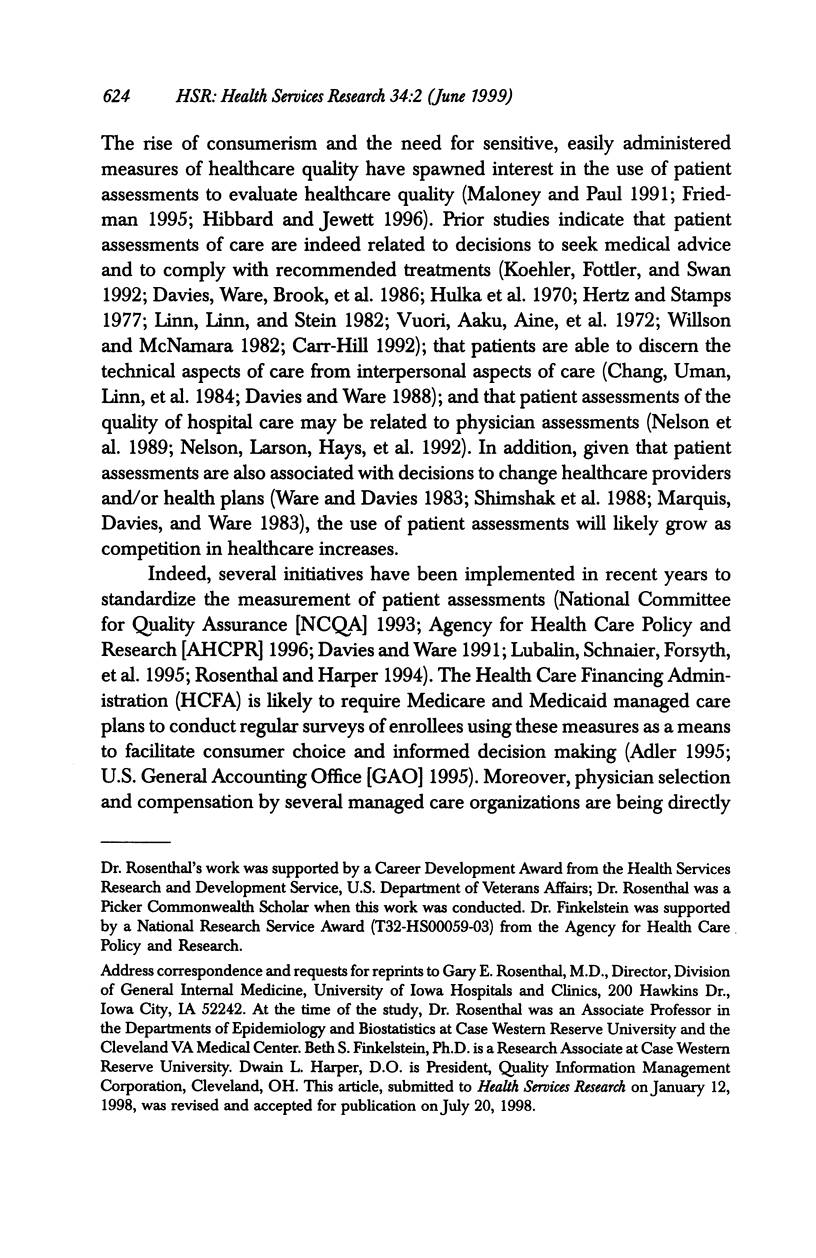


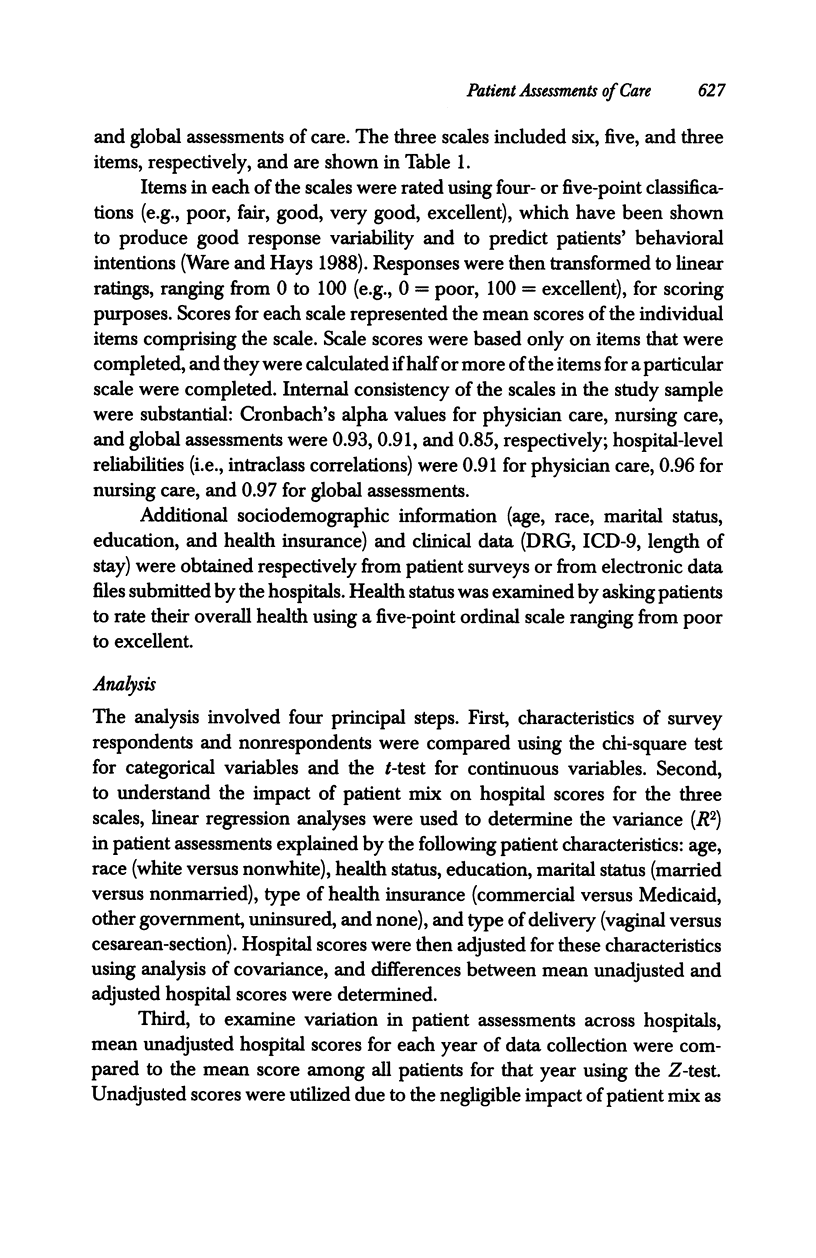
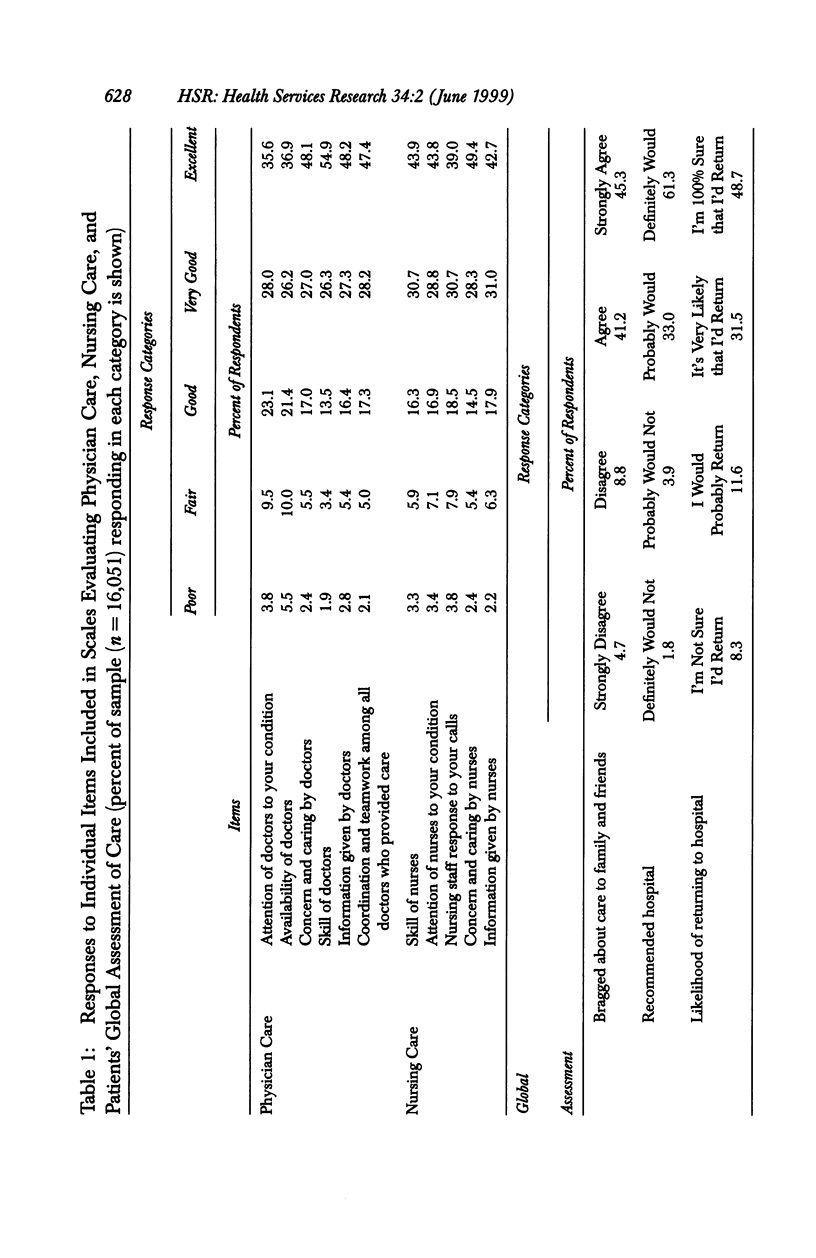
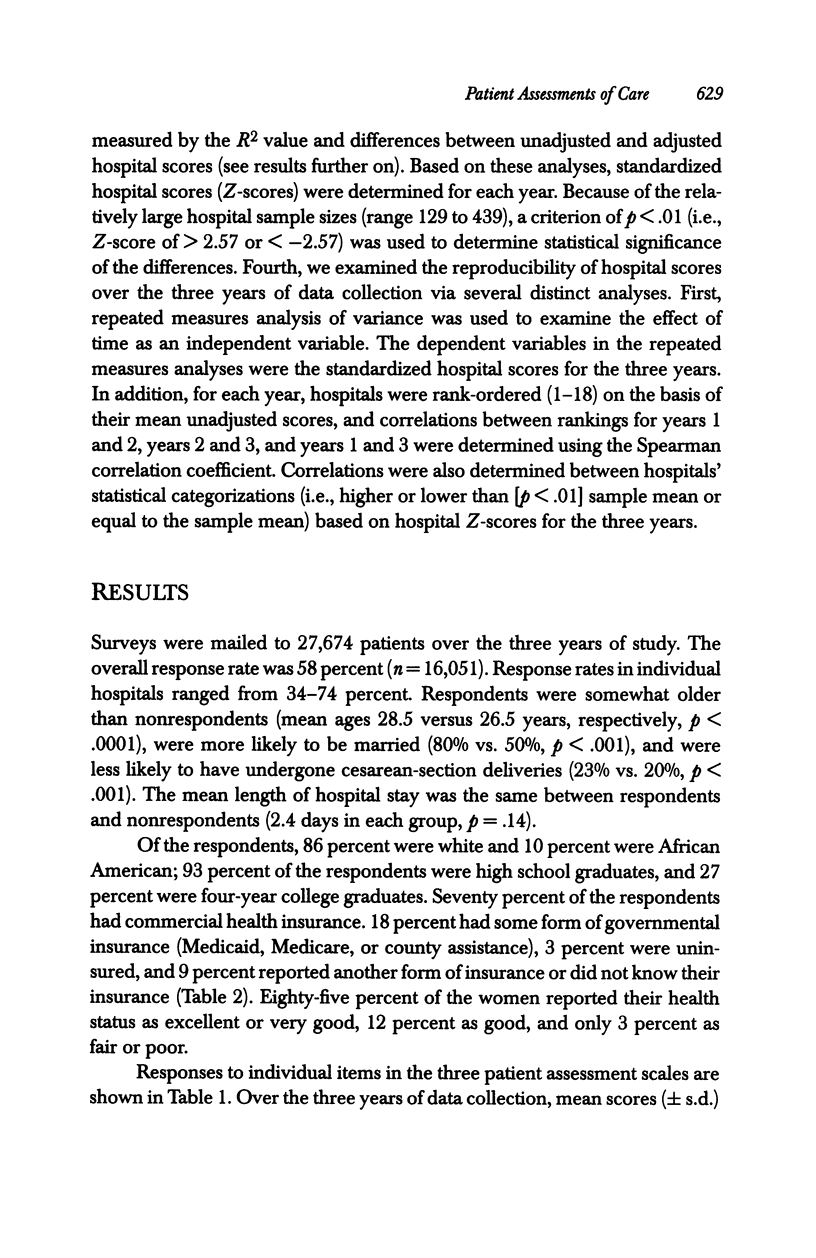
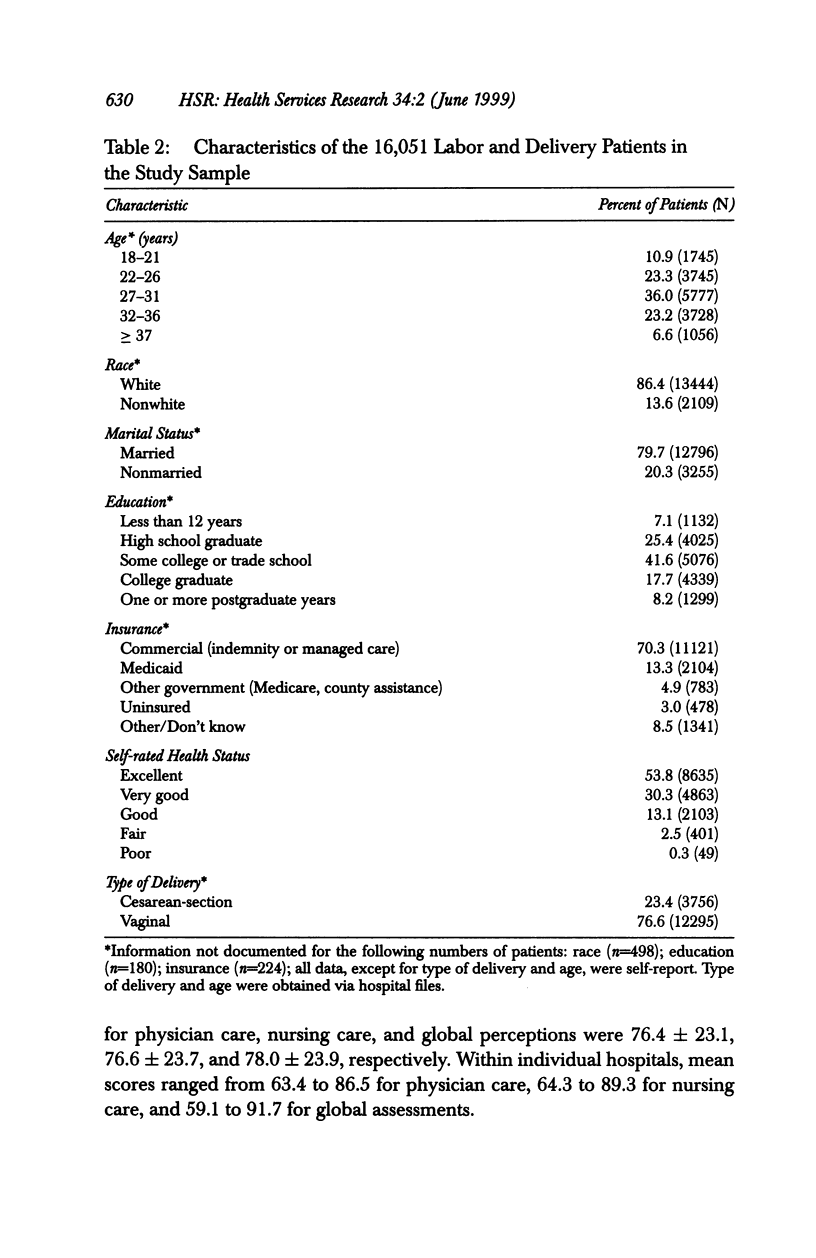

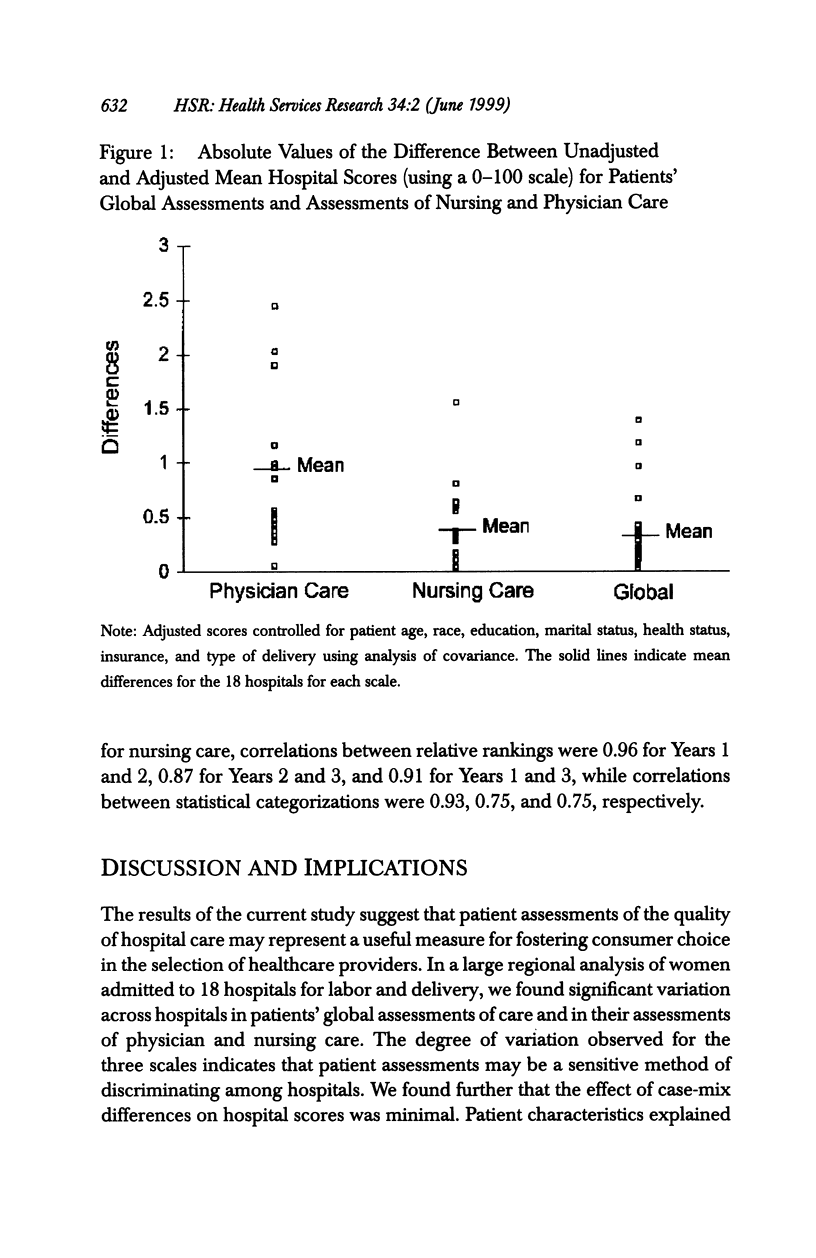



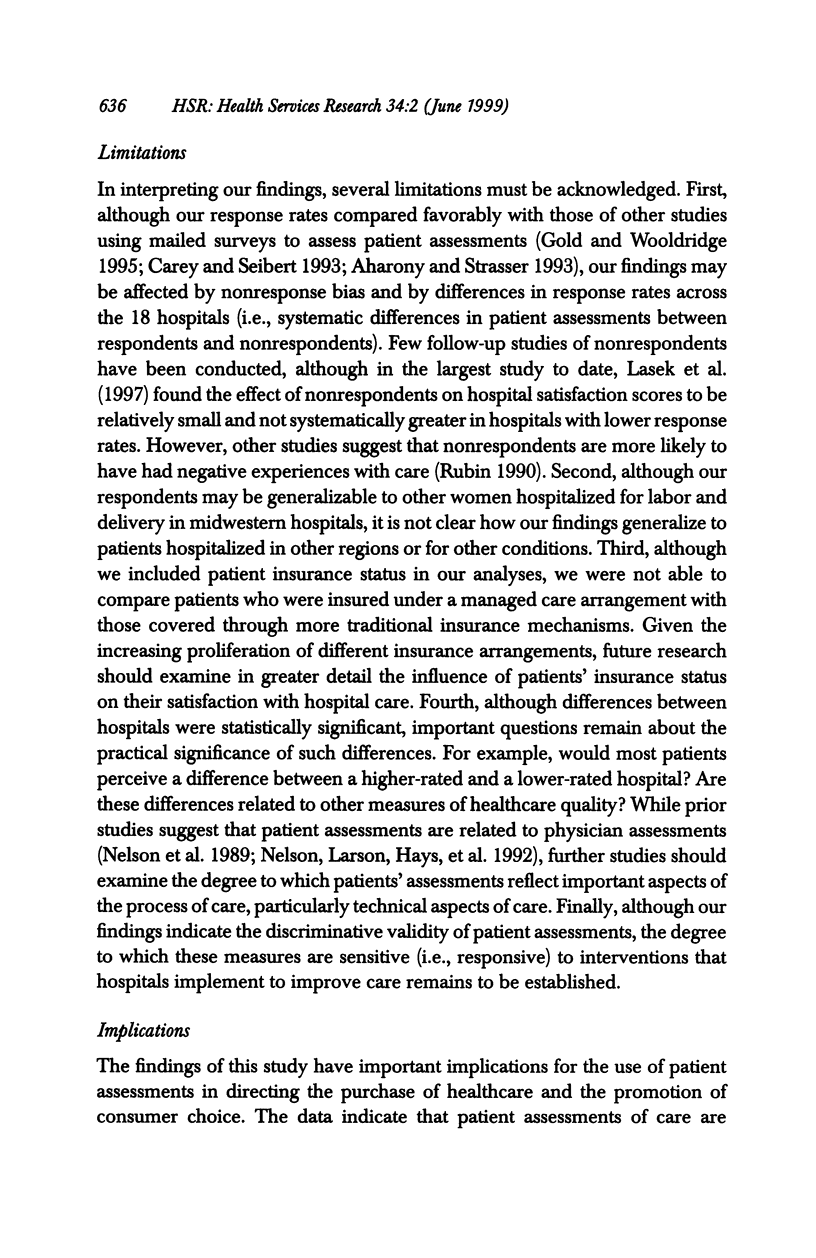
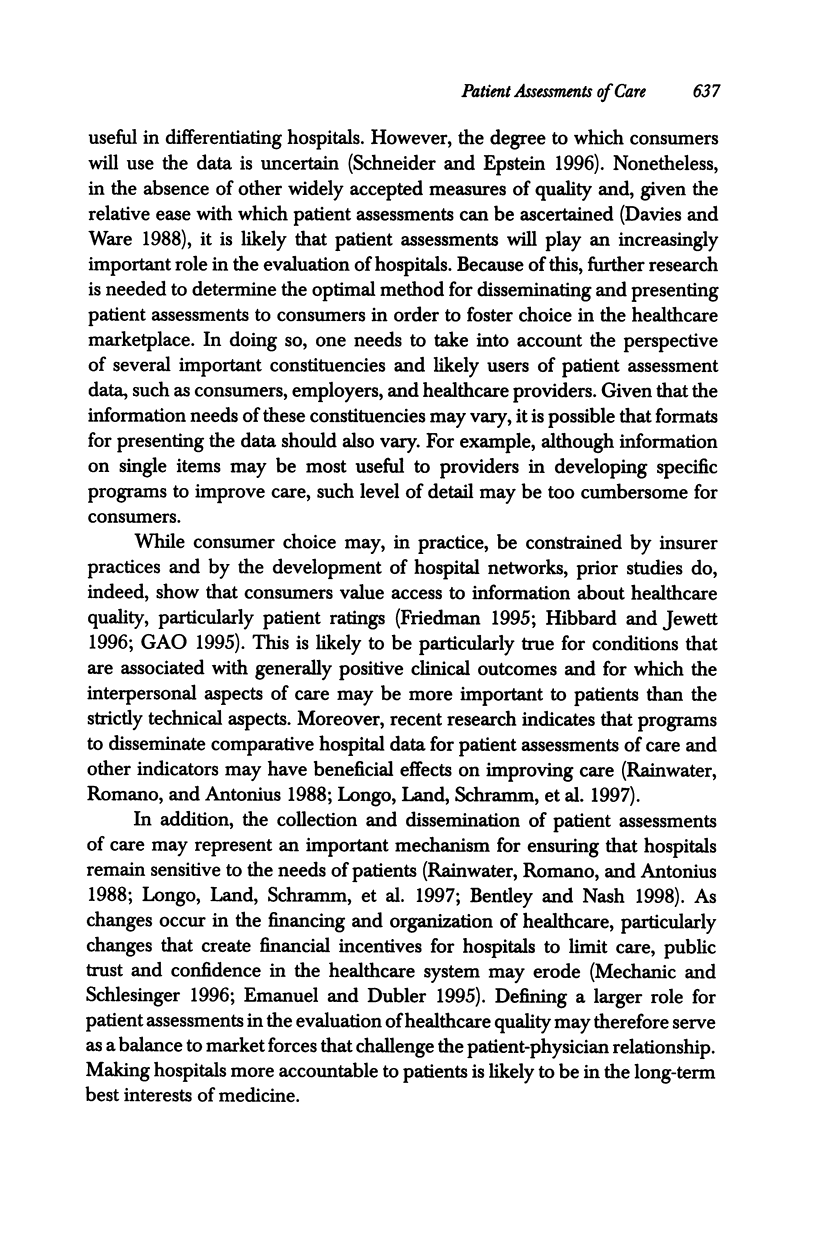
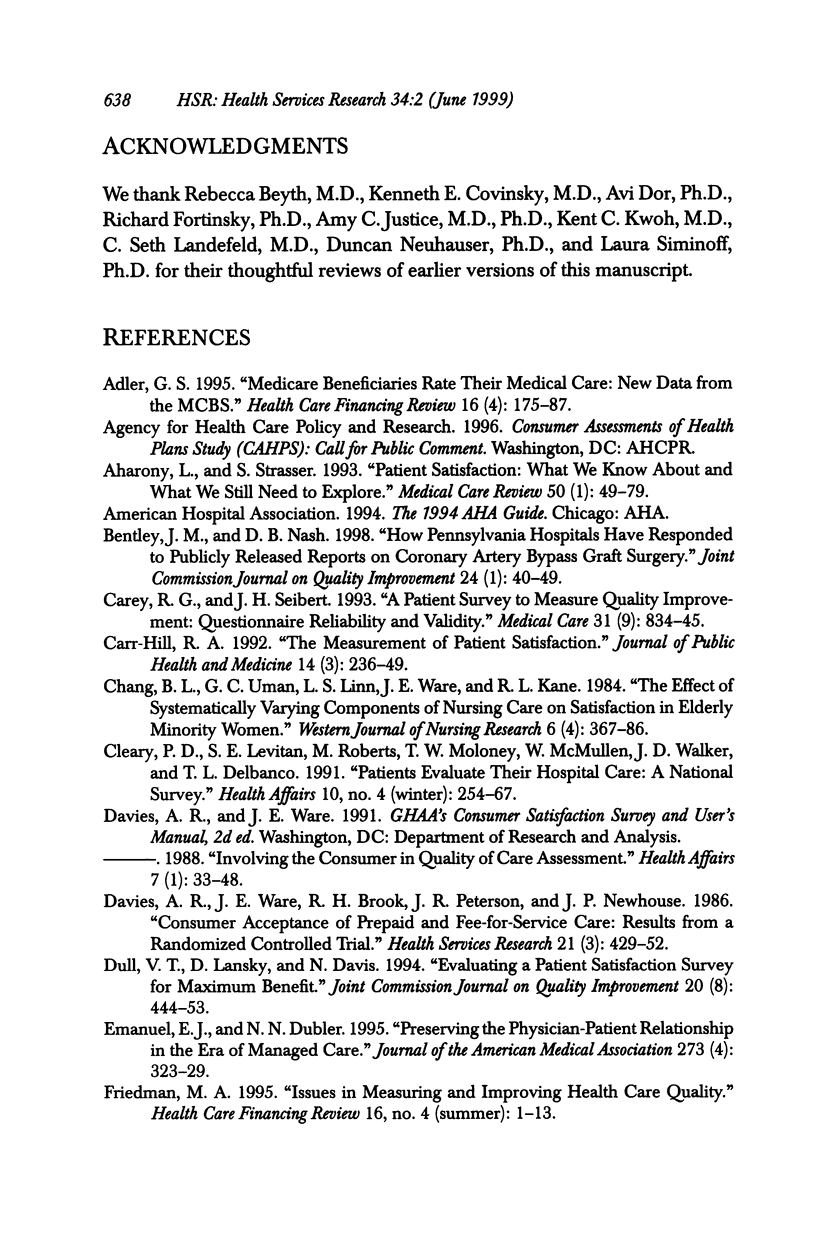
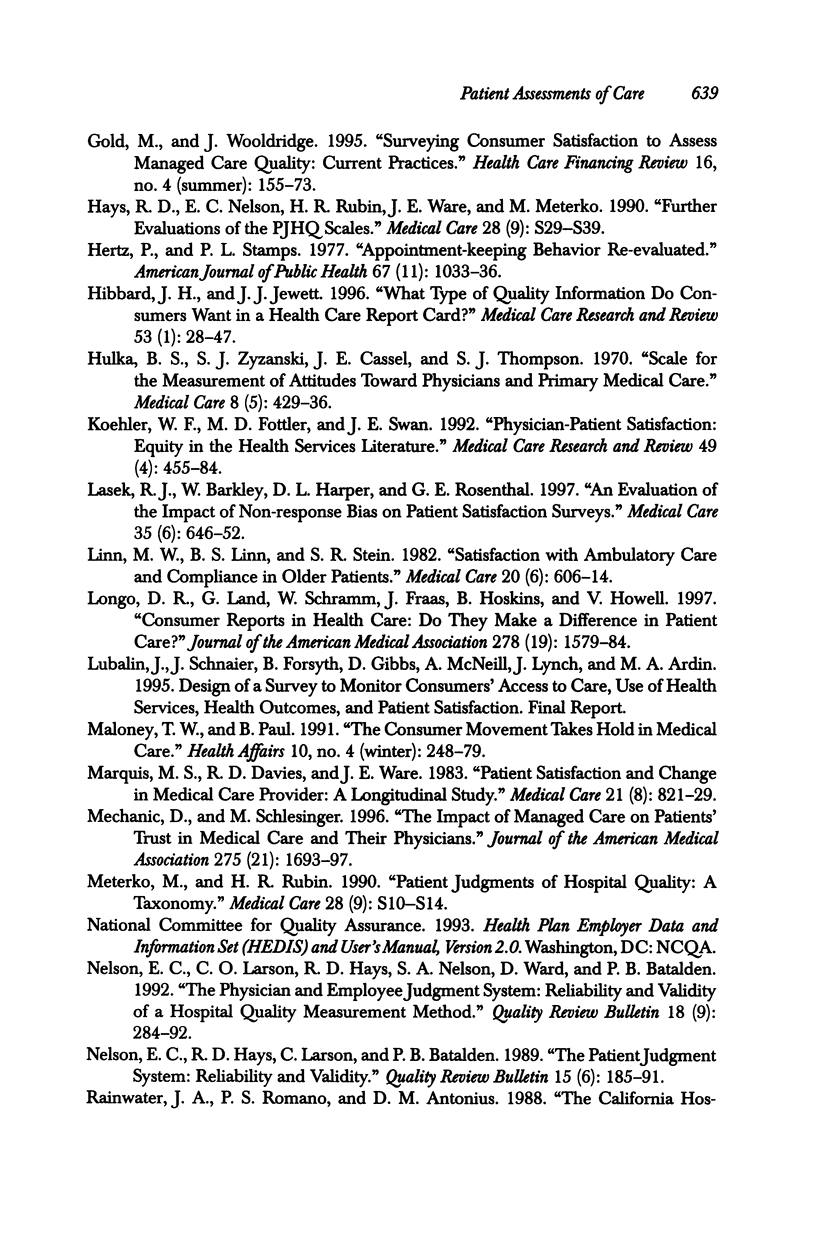
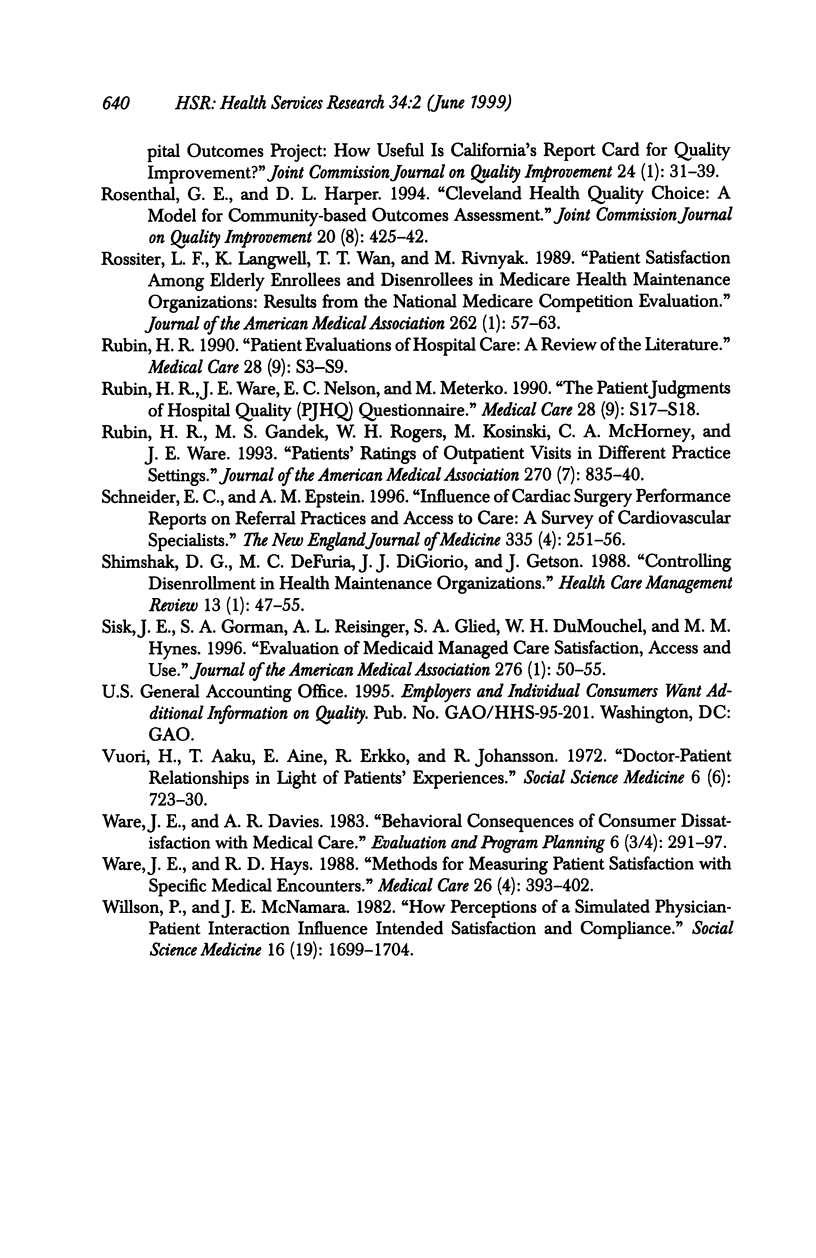
Selected References
These references are in PubMed. This may not be the complete list of references from this article.
- Adler G. S. Medicare beneficiaries rate their medical care: new data from the MCBS (Medicare Current Beneficiary Survey). Health Care Financ Rev. 1995 Summer;16(4):175–187. [PMC free article] [PubMed] [Google Scholar]
- Aharony L., Strasser S. Patient satisfaction: what we know about and what we still need to explore. Med Care Rev. 1993 Spring;50(1):49–79. doi: 10.1177/002570879305000104. [DOI] [PubMed] [Google Scholar]
- Bentley J. M., Nash D. B. How Pennsylvania hospitals have responded to publicly released reports on coronary artery bypass graft surgery. Jt Comm J Qual Improv. 1998 Jan;24(1):40–49. doi: 10.1016/s1070-3241(16)30358-3. [DOI] [PubMed] [Google Scholar]
- Carey R. G., Seibert J. H. A patient survey system to measure quality improvement: questionnaire reliability and validity. Med Care. 1993 Sep;31(9):834–845. doi: 10.1097/00005650-199309000-00008. [DOI] [PubMed] [Google Scholar]
- Carr-Hill R. A. The measurement of patient satisfaction. J Public Health Med. 1992 Sep;14(3):236–249. [PubMed] [Google Scholar]
- Chang B. L., Uman G. C., Linn L. S., Ware J. E., Jr, Kane R. L. The effect of systematically varying components of nursing care on satisfaction in elderly ambulatory women. West J Nurs Res. 1984 Fall;6(4):367–386. doi: 10.1177/019394598400600402. [DOI] [PubMed] [Google Scholar]
- Cleary P. D., Edgman-Levitan S., Roberts M., Moloney T. W., McMullen W., Walker J. D., Delbanco T. L. Patients evaluate their hospital care: a national survey. Health Aff (Millwood) 1991 Winter;10(4):254–267. doi: 10.1377/hlthaff.10.4.254. [DOI] [PubMed] [Google Scholar]
- Davies A. R., Ware J. E., Jr, Brook R. H., Peterson J. R., Newhouse J. P. Consumer acceptance of prepaid and fee-for-service medical care: results from a randomized controlled trial. Health Serv Res. 1986 Aug;21(3):429–452. [PMC free article] [PubMed] [Google Scholar]
- Dull V. T., Lansky D., Davis N. Evaluating a patient satisfaction survey for maximum benefit. Jt Comm J Qual Improv. 1994 Aug;20(8):444–453. doi: 10.1016/s1070-3241(16)30089-x. [DOI] [PubMed] [Google Scholar]
- Emanuel E. J., Dubler N. N. Preserving the physician-patient relationship in the era of managed care. JAMA. 1995 Jan 25;273(4):323–329. [PubMed] [Google Scholar]
- Friedman M. A. Issues in measuring and improving health care quality. Health Care Financ Rev. 1995 Summer;16(4):1–13. [PMC free article] [PubMed] [Google Scholar]
- Gold M., Wooldridge J. Surveying consumer satisfaction to assess managed-care quality: current practices. Health Care Financ Rev. 1995 Summer;16(4):155–173. [PMC free article] [PubMed] [Google Scholar]
- Hays R. D., Nelson E. C., Rubin H. R., Ware J. E., Jr, Meterko M. Further evaluations of the PJHQ scales. Med Care. 1990 Sep;28(9 Suppl):S29–S39. doi: 10.1097/00005650-199009001-00008. [DOI] [PubMed] [Google Scholar]
- Hertz P., Stamps P. L. Appointment-keeping behavior re-evaluated. Am J Public Health. 1977 Nov;67(11):1033–1036. doi: 10.2105/ajph.67.11.1033. [DOI] [PMC free article] [PubMed] [Google Scholar]
- Hibbard J. H., Jewett J. J. What type of quality information do consumers want in a health care report card? Med Care Res Rev. 1996 Mar;53(1):28–47. doi: 10.1177/107755879605300102. [DOI] [PubMed] [Google Scholar]
- Hulka B. S., Zyzanski S. J., Cassel J. C., Thompson S. J. Scale for the measurement of attitudes toward physicians and primary medical care. Med Care. 1970 Sep-Oct;8(5):429–436. doi: 10.1097/00005650-197009000-00010. [DOI] [PubMed] [Google Scholar]
- Koehler W. F., Fottler M. D., Swan J. E. Physician-patient satisfaction: equity in the health services encounter. Med Care Rev. 1992 Winter;49(4):455–484. doi: 10.1177/002570879204900404. [DOI] [PubMed] [Google Scholar]
- Lasek R. J., Barkley W., Harper D. L., Rosenthal G. E. An evaluation of the impact of nonresponse bias on patient satisfaction surveys. Med Care. 1997 Jun;35(6):646–652. doi: 10.1097/00005650-199706000-00009. [DOI] [PubMed] [Google Scholar]
- Linn M. W., Linn B. S., Stein S. R. Satisfaction with ambulatory care and compliance in older patients. Med Care. 1982 Jun;20(6):606–614. doi: 10.1097/00005650-198206000-00006. [DOI] [PubMed] [Google Scholar]
- Longo D. R., Land G., Schramm W., Fraas J., Hoskins B., Howell V. Consumer reports in health care. Do they make a difference in patient care? JAMA. 1997 Nov 19;278(19):1579–1584. [PubMed] [Google Scholar]
- Marquis M. S., Davies A. R., Ware J. E., Jr Patient satisfaction and change in medical care provider: a longitudinal study. Med Care. 1983 Aug;21(8):821–829. doi: 10.1097/00005650-198308000-00006. [DOI] [PubMed] [Google Scholar]
- Mechanic D., Schlesinger M. The impact of managed care on patients' trust in medical care and their physicians. JAMA. 1996 Jun 5;275(21):1693–1697. [PubMed] [Google Scholar]
- Meterko M., Rubin H. R. Patient judgments of hospital quality. A taxonomy. Med Care. 1990 Sep;28(9 Suppl):S10–S14. doi: 10.1097/00005650-199009001-00003. [DOI] [PubMed] [Google Scholar]
- Nelson E. C., Hays R. D., Larson C., Batalden P. B. The patient judgment system: reliability and validity. QRB Qual Rev Bull. 1989 Jun;15(6):185–191. doi: 10.1016/s0097-5990(16)30290-1. [DOI] [PubMed] [Google Scholar]
- Nelson E. C., Larson C. O., Hays R. D., Nelson S. A., Ward D., Batalden P. B. The physician and employee judgment system: reliability and validity of a hospital quality measurement method. QRB Qual Rev Bull. 1992 Sep;18(9):284–292. doi: 10.1016/s0097-5990(16)30545-0. [DOI] [PubMed] [Google Scholar]
- Rosenthal G. E., Harper D. L. Cleveland health quality choice: a model for collaborative community-based outcomes assessment. Jt Comm J Qual Improv. 1994 Aug;20(8):425–442. doi: 10.1016/s1070-3241(16)30088-8. [DOI] [PubMed] [Google Scholar]
- Rossiter L. F., Langwell K., Wan T. T., Rivnyak M. Patient satisfaction among elderly enrollees and disenrollees in Medicare health maintenance organizations. Results from the National Medicare Competition Evaluation. JAMA. 1989 Jul 7;262(1):57–63. [PubMed] [Google Scholar]
- Rubin H. R., Gandek B., Rogers W. H., Kosinski M., McHorney C. A., Ware J. E., Jr Patients' ratings of outpatient visits in different practice settings. Results from the Medical Outcomes Study. JAMA. 1993 Aug 18;270(7):835–840. [PubMed] [Google Scholar]
- Rubin H. R. Patient evaluations of hospital care. A review of the literature. Med Care. 1990 Sep;28(9 Suppl):S3–S9. doi: 10.1097/00005650-199009001-00002. [DOI] [PubMed] [Google Scholar]
- Rubin H. R., Ware J. E., Jr, Nelson E. C., Meterko M. The Patient Judgments of Hospital Quality (PJHQ) Questionnaire. Med Care. 1990 Sep;28(9 Suppl):S17–S18. doi: 10.1097/00005650-199009001-00005. [DOI] [PubMed] [Google Scholar]
- Schneider E. C., Epstein A. M. Influence of cardiac-surgery performance reports on referral practices and access to care. A survey of cardiovascular specialists. N Engl J Med. 1996 Jul 25;335(4):251–256. doi: 10.1056/NEJM199607253350406. [DOI] [PubMed] [Google Scholar]
- Shimshak D. G., DeFuria M. C., DiGiorgio J. J., Getson J. Controlling disenrollment in health maintenance organizations. Health Care Manage Rev. 1988 Winter;13(1):47–55. [PubMed] [Google Scholar]
- Sisk J. E., Gorman S. A., Reisinger A. L., Glied S. A., DuMouchel W. H., Hynes M. M. Evaluation of Medicaid managed care. Satisfaction, access, and use. JAMA. 1996 Jul 3;276(1):50–55. [PubMed] [Google Scholar]
- Vuori H., Aaku T., Aine E., Erkko R., Johansson R. Doctor-patient relationship in the light of patients' experiences. Soc Sci Med. 1972 Dec;6(6):723–730. doi: 10.1016/0037-7856(72)90044-3. [DOI] [PubMed] [Google Scholar]
- Ware J. E., Jr, Davies A. R. Behavioral consequences of consumer dissatisfaction with medical care. Eval Program Plann. 1983;6(3-4):291–297. doi: 10.1016/0149-7189(83)90009-5. [DOI] [PubMed] [Google Scholar]
- Ware J. E., Jr, Hays R. D. Methods for measuring patient satisfaction with specific medical encounters. Med Care. 1988 Apr;26(4):393–402. doi: 10.1097/00005650-198804000-00008. [DOI] [PubMed] [Google Scholar]
- Willson P., McNamara J. R. How perceptions of a simulated physician-patient interaction influence intended satisfaction and compliance. Soc Sci Med. 1982;16(19):1699–1704. doi: 10.1016/0277-9536(82)90095-8. [DOI] [PubMed] [Google Scholar]


